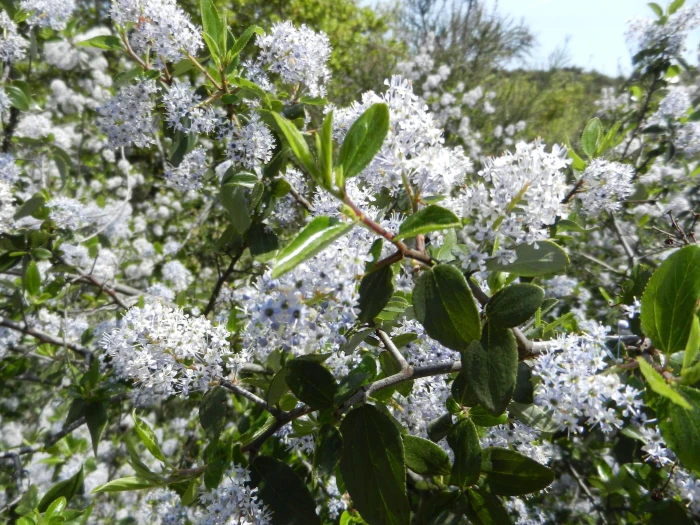Jimbrush
(Ceanothus sorediatus)
Jimbrush (Ceanothus sorediatus)
/
/

Bruce Bailey
CC BY 4.0
Image By:
Bruce Bailey
Recorded By:
Copyright:
CC BY 4.0
Copyright Notice:
Photo by: Bruce Bailey | License Type: CC BY 4.0 | License URL: http://creativecommons.org/licenses/by/4.0/ | Rights Holder: Bruce Bailey | Publisher: iNaturalist | Date Created: 2012-04-07T11:52:55-07:00 |
























Estimated Native Range
Climate Requirements for Englewood, New Jersey
| This Plant | Your Site | Plant Suitability for Your Location | ||
|---|---|---|---|---|
| • Precipitation | 12" - 81" | 47" | Aquatic | Aquatic |
| • High Temp. | 68°F - 98°F | 85°F | Your summer temperatures are normal for this plant. | Excellent |
| • Low Temp. | 26°F - 44°F | 22°F | Your winter temperatures may be too cold for this plant | Too cold |
This plant may not grow well at your location - your precipitation is too high.
Summary
Ceanothus sorediatus, commonly known as Jimbrush or Buckbrush, is an evergreen shrub native to the chaparral and coastal sage scrub of California and Baja California. It thrives in these Mediterranean climates, often on dry, rocky slopes and in canyons. Jimbrush typically grows to a height of up to 10 feet with a similar spread, featuring small, dark green, glandular-toothed leaves that are highly aromatic when crushed. From late winter to early summer, it produces dense clusters of tiny, intensely blue or purple flowers, which are highly attractive to pollinators such as bees and butterflies.
Jimbrush is valued for its drought tolerance and ability to thrive in poor soils, making it an excellent choice for water-wise gardens and natural landscaping in suitable climates. It is also used for erosion control on slopes and as a habitat plant for wildlife. In cultivation, it requires minimal water once established, well-drained soils, and full sun to part shade. While generally low-maintenance, it can be susceptible to root rot if overwatered and may attract pests such as aphids. There are no popular garden cultivars of this species, but its natural form is well-suited to informal hedges or as a specimen plant in native plant gardens.CC BY-SA 4.0
Jimbrush is valued for its drought tolerance and ability to thrive in poor soils, making it an excellent choice for water-wise gardens and natural landscaping in suitable climates. It is also used for erosion control on slopes and as a habitat plant for wildlife. In cultivation, it requires minimal water once established, well-drained soils, and full sun to part shade. While generally low-maintenance, it can be susceptible to root rot if overwatered and may attract pests such as aphids. There are no popular garden cultivars of this species, but its natural form is well-suited to informal hedges or as a specimen plant in native plant gardens.CC BY-SA 4.0
Plant Description
- Plant Type: Shrub
- Height: 3-10 feet
- Width: 3-10 feet
- Growth Rate: Moderate
- Flower Color: Blue, Purple, White
- Flowering Season: Spring, Summer
- Leaf Retention: Evergreen
Growth Requirements
- Sun: Full Sun, Part Shade
- Water: Low
- Drainage: Medium, Fast
Common Uses
Bird Garden, Butterfly Garden, Deer Resistant, Drought Tolerant, Low Maintenance, Showy Flowers
Natural Habitat
Native to chaparral and coastal sage scrub of California and Baja California
Other Names
Common Names: Sticky Ceanothus
Scientific Names: Ceanothus sorediatus, Ceanothus collinus, Ceanothus collinus, Ceanothus hirsutus var. glaber, Ceanothus intricatus, Ceanothus nitidus, Ceanothus oliganthus subsp. sorediatus, Ceanothus oliganthus var. sorediatus, Ceanothus sorediatus var. glaber
GBIF Accepted Name: Ceanothus sorediatus